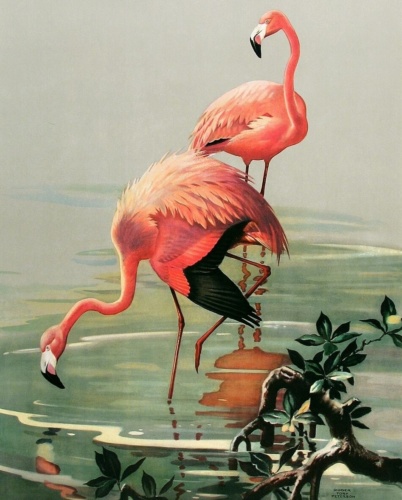Roger Tory Peterson’s Botanicals
“Birds have wings; they can travel, mix, and standardize their populations. They usually look precisely the way they are supposed to look (unless they are in molt). On the other hand, flowers are rooted to the earth. They are often separated by broad barriers of unsuitable environment from other “stations” of their own species.” – excerpt from Roger Tory Peterson’s introduction to the Peterson Field Guide to Wildflowers 
Roger Tory Peterson’s fame and popularity as a bird artist has often overshadowed other notable projects he completed throughout his career. Twenty years before its publication, the Peterson Field Guide to Wildflowers of Northeastern/North-central North America was discussed by Peterson and Margaret McKenny, his partner on the project. Although initially acting as only the editor for the Wildflowers guide, due to the absence of an illustrator, Peterson took on creating the illustrations himself. He created more than 1,500 drawings of flowers, 1,344 of which were included in the book. Peterson spent years traveling thousands of miles to capture flower species during their brief bloom periods. Most of his illustrations were drawn in motels during his flower seeking travels. “In my suitcase I carried a 200-watt day bulb that I often substituted for the weak 40- or 60-watt bulb in my quarters…I am able to look at each drawing and bring back by association the place where I found the flower, the circumstances in which I drew it, and incidents – some pleasant, other trying.”
The book includes both vibrant color plates and intricate black and white depictions of species. In addition, Peterson even created ink symbol drawings representing each flower family. As with his bird guides, this project was completed in such a way as to offer a shortcut to species identification. His Peterson Identification System of including arrows to highlight distinguishing characteristics again made it possible for the amateur botanist or nature enthusiast to identify wildflowers.
On view in the Institute’s second-floor library gallery are framed, original color plates from the book, as well as some of the numerous black and white works Peterson perfected.
As spring unfolds around us, so do the wondrous species of wildflowers that Peterson captured in this book. Discover these beauties again, or for the first time, and remember the remarkable tool that will guide you – the Peterson Field Guide to Wildflowers.
Roger Tory Peterson: The Quaker State Years
In 1942, Roger Tory Peterson visited Quaker State Lithographing Company in New York City with his recently completed “Cardinals” original painting. The Company was formed in 1939 by Gertrude Gerstel Steinberg, a former bookkeeper and printing business office manager. Peterson offered to sell Steinberg his painting for $75. She was impressed by his exquisitely rendered painting and immediately offered him royalties from sales of lithographed reproductions of “Cardinals” made by her company. Endorsed by the National Audubon Society, the print sold 10,000 copies in the first year and earned Peterson $2,500 in royalties.

“Flamingoes” by Roger Tory Peterson, Copyright 1946, Quaker State Lithographing Company, Inc.
This was the beginning of a professional relationship between Steinberg and Peterson that would last nearly twenty years. Peterson’s “Cardinals” painting was responsible for converting Steinberg and her business to that of bird illustrations. During their years of collaboration, Steinberg had 65 Peterson originals lithographed – a process that could take three months or more to achieve precise reproduction.
Following the publication of Peterson’s revolutionary “A Field Guide to the Birds” in 1934, the relationship between Peterson and Quaker State enabled widespread distribution and knowledge of his breathtaking early Audubonesque paintings to a large public audience. An article written for the Victorville Daily Press in 1977 stated “By producing as many as 6,000 copies of each Roger Tory Peterson painting, Steinberg’s lithography was another step in putting Peterson’s discerning eye before the American public and, in turn, making them more aware of the natural world around them.”
The Institute received a generous donation of 4 original Peterson lithographs, along with supporting memorabilia, from the grandson of Mrs. Steinberg, Peter Schonberg, in 2019. Mr. Schonberg’s donation, along with 8 lithographs from the Peterson Collection, were framed in late 2019, thus featured in the Institute’s galleries for the very first time.




